|
|
 |
|
Harpacticoida ( Order ) |
|
|
|
Clytemnestridae ( Family ) |
|
|
|
Goniopsyllus ( Genus ) |
|
|
| |
Goniopsyllus dokdoensis Cho, Kim & Lee, 2010 (F,M) | |
| | | | | | | Syn.: | ? Clytemnestra rostrata : Jang M.-C & al., 2012 (p.37, Table 3, abundance and seasonal distribution); | | | | Ref.: | | | Cho & al., 2010 (p.122, Descr. F,M, figs. F,M, Rem.) |  Issued from : K.H. Cho, W.-S. Kim & W. Lee in Proc. Biol. Soc. Washigton, 2010, 123 (2). [p.123, Fig.1]. Female (from 37°37°15'N, 131°46'E): A, habitus (dorsal); B, Distal portion of A1; segment 6 (arrowed indicates rudimentary element); C, Telson and caudal ramus (dorsal; setae I-VII indicated). Scale bars in µm. Nota: Posterolateral angles of cephalothorax slightly expanded. - Somites bearing P2-P4 successively decreasing in width posteriorly, with weakly produced alate processes, less protuberant than those in G. clausi. - Urosome 5-segmented, comprised of P5-bearing somite, genital double-somite and 3 free abdominal somites. armed with pores and sensilla, however without dorsal ornamentation of spinular patches in dorsal view. - Anal somite (telson) without well-developed anal operculum, flanked by a pair of sensilla dorsally (fig.1C) - Caudal rami slightly longer than wide, tilted inwardly; lozenge-shaped, produced into conical process bearing terminal pore; with several ventral pores. Setae I-II bipinnate, stout and strongly developed; seta I 1.5 times as long as seta II, extending beyond apex of caudal ramus. Seta III bipinnate. Seta III bipinnate. Seta IV and V basally fused, without fracture planes, multibipinnate and spiniform; seta V about 1.5 times ramus length. Seta VI tiny, bare. Seta VII bare, close to middle of inner lateral margin and triarticulated. A1 6-segmented, segment 1 with small pore near seta and row of long setules along anterior margin. Segment 6 with acrothek; apical acrothek consisting of 1 aesthetasc, 1 long modified seta, and 1 short bare seta; rudimentary element present at base of acrothek (arrowed in fig. 1B').
|
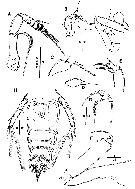 Issued from : K.H. Cho, W.-S. Kim & W. Lee in Proc. Biol. Soc. Washigton, 2010, 123 (2). [p.125, Fig.2]. Female: A, A2; B, oral area showing positions od Md, Mx1, Mx2 and Mxp; C, Md; D, Mx1; E, Mx2; F, Mxp (posterior); G, same (anterior); H, urosome (ventral, including P5-bearing somite). Scale bars in µm. Nota: Urosomal posterior 3 somites with patches of dense spinules along posterior margin ventrally. - Genital double-somite slightly constricted bilaterally with discontinuous internal chitinous structure indicating original segmentation. Copulatory pore located medially in large circular depression, with additional pores flanking copulatory pore. Genital apertures located near anterior margin of genital double-somite, consisting of small opercula (derived from vestigial P6; each P6 with 1 naked seta). - Telson with multiple rows of spinules along posterior margin ventrally. - A2 4-segmented, comprising coxa, basis, and 2-segmented endopod. Exopod 1-segmented, forming small membranous peduncle bearing stout and recurved apical seta, located near membranous area between basis and endopod. Exopodal seta multipinnate, spinules on proximal third clearly longer. Proximal endopodal segment with few scattered denticles. Distal endopodal segment 1.5 times longer than proximal one; distal segment with 4 large frills and minute spinules on outer surface; with 1 pinnate seta laterally, and 1 subapical and 3 apical, bipinnate or multipinnate elements. - Md reduced; palp represented by single naked seta. Gnathobase long and narrow, with several cuspodate processes apically and subapically; dorsal seta absent. - Mx1 reduced; reptresented by small lozange-shaped segment bearing naked apical seta and with 1 pore near apical seta. - Mx2 2-segmented, comprising elongate syncoxa and allobasis; coxal endite laterally lobate, with 2 naked setae apically. Allobasis with large strong naked claw distally, smaller inner spine, and pinnate seta along outer margin. - Mxp large and elongated; 3-segmented, comprising syncoxa, basis, and endopod. Syncoxa elongate, longer than basis, and well-developed proximal pedestal area; 1 anterior plumose seta. Basis elongate; distal area of palmar margin with dense spinule rows and 2 elements located close to articulation with endopod; proximal element spiniform and bare, distal element stocky and spinulose. Endopod represented by short element bearing naked and hook-shaped claw; accessory armature consisting of 2 posterior and 3 anterior setae. - P5 uniramous, 2-segmented, comprising basis and 1-segmented exopod; not extending to distal margin of genital double-somite. Basis with short outer seta and pore near proximal margin on border of body somite. Exopod about 1.55 rtimes as long as basis, diverging outwards; outer margin with 2 pinnate setae and 3 pores; inner margin with 1 long plumose seta; apex with 1 pinnate and 1 plumose seta.
|
 Issued from : K.H. Cho, W.-S. Kim & W. Lee in Proc. Biol. Soc. Washigton, 2010, 123 (2). [p.126, Fig.3]. Female; A, P1 (posterior); B, P2 (anterior). Scale bars in µm.
|
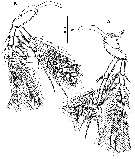 Issued from : K.H. Cho, W.-S. Kim & W. Lee in Proc. Biol. Soc. Washigton, 2010, 123 (2). [p.127, Fig.4]. Female: A, P3 (anterior); B, P4 (anterior). Scale bars in µm.
|
 Issued from : K.H. Cho, W.-S. Kim & W. Lee in Proc. Biol. Soc. Washigton, 2010, 123 (2). [p.128]. Female & Male: setal formula of swimming legs P1 to P4.
|
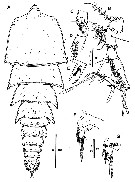 Issued from : K.H. Cho, W.-S. Kim & W. Lee in Proc. Biol. Soc. Washigton, 2010, 123 (2). [p.129, Fig.5]. Male (from 37°09'N, 132°01'E): A, habitus (dorsal); B, A1 (ventral); C, A1 segments 3-4 (anterior, arrowed indicates segment 4); D, A1 segment 5 (anterior); E, A1 segment 6 (anterior); F, telson and caudal ramus (dorsal); G, telson and caudal ramus (ventral). Scale bars in µm. Nota: Sexual dimorphism in A1, Mxp, P5, P6 and genital field. - Rostrum slightly smaller, and more pointed than in female.
|
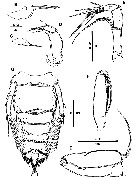 Issued from : K.H. Cho, W.-S. Kim & W. Lee in Proc. Biol. Soc. Washigton, 2010, 123 (2). [p.130, Fig.6]. Male: A, A2; B, Md; C, Mx1; D, Mx2; E, Mxp (anterior); F, basis and endopod of Mxp (posterior); G, urosome (ventral; including P5-bearing somite). Scale bars in µm. Nota: P5 exopod slightly shorter than in female. Exopod 1.35 times longer than basis. - P6 asymmetrical, represented by highly membranous non-articulating flaps covering single, large genital aperture; each lobe with 2 setae at outer distal corner.
|
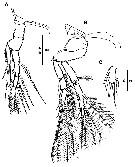 Issued from : K.H. Cho, W.-S. Kim & W. Lee in Proc. Biol. Soc. Washigton, 2010, 123 (2). [p.131, Fig.7]. Male: A, P1 (anterior); B, P2 (anterior); C, left P2 exopodite 3, aberrant (anterior). Scale bars in µm.
|
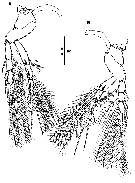 Issued from : K.H. Cho, W.-S. Kim & W. Lee in Proc. Biol. Soc. Washigton, 2010, 123 (2). [p.132, Fig.8]. Male: A, P3 (anterior); B, P4 (anterior). Scale bars in µm .
|
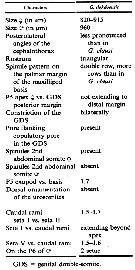 Issued from : K.H. Cho, W.-S. Kim & W. Lee in Proc. Biol. Soc. Washigton, 2010, 123 (2). [p.134, Table 1]. Diagnostic characteristics. Nota: Compare with G. clausi, G. rostratus, G. brasiliensis.
| | | | | NZ: | 1 | | |
|
Distribution map of Goniopsyllus dokdoensis by geographical zones
|
| | | | Loc: | | | East Sea Korea (Japan Sea) (near Dokdo Island), Korea Strait.
Type locality: 37°15' N, 131°46' E.
Nota: Cho & al. (2010, p.135) point out that the records of Clytemnestra rostrata in Korean waters in the previous studies are possibly misidentifications of the current new species G. dokdoensis. | | | | N: | 1 + ? 1 | | | | Lg.: | | | (1181) F: 0,820-0,915; M: 0,960; {F: 0,820-0,915; M: 0,960} | | | | Rem.: | For Cho & al. (2010, p.131) this species is closely related to G. clausi; however G. dokdoensis differs friom its congeners with respect to several diagnostic characteristics. First G. dokdoensis has the smallest size of all of the species of Gonopsyllus. Second, the female of G. dokdoensis has additional pores around the copulatory pore. Third, there are differences in the patterns of spinular ornamentation on the urosomites between dokdoensis and the other species. Fourth, there are differences in the relative lengths from seta II to seta I and from seta V to the caudal ramus. Finally, the most striking apomorphy in the new species is present in the male; the male has 2 setae at the outer distal corner of P6 (the male of G. clausi has only 1 seta at this location). In addition, the distal endopod segment in A2 has 4 large surface frills and minute spinules on the outer surface (but only 3 frills in G. clausi). Additionally, the male has some morphological variations: the outermost apical seta on the exopod of the right P5 is much longer than the one on the left P5. The left exopod-3 of P2 is aberrant and has 1 additional inner seta than the corresponding right segment (aberrant setation of P2 was also reported in Clytemnestra scutellata, with the male right P2 exopod-3 displaying a reduced number of outer setae. | | | Last update : 17/09/2015 | |
|
|
 Any use of this site for a publication will be mentioned with the following reference : Any use of this site for a publication will be mentioned with the following reference :
Razouls C., Desreumaux N., Kouwenberg J. and de Bovée F., 2005-2025. - Biodiversity of Marine Planktonic Copepods (morphology, geographical distribution and biological data). Sorbonne University, CNRS. Available at http://copepodes.obs-banyuls.fr/en [Accessed December 17, 2025] © copyright 2005-2025 Sorbonne University, CNRS
|
|
 |
 |












